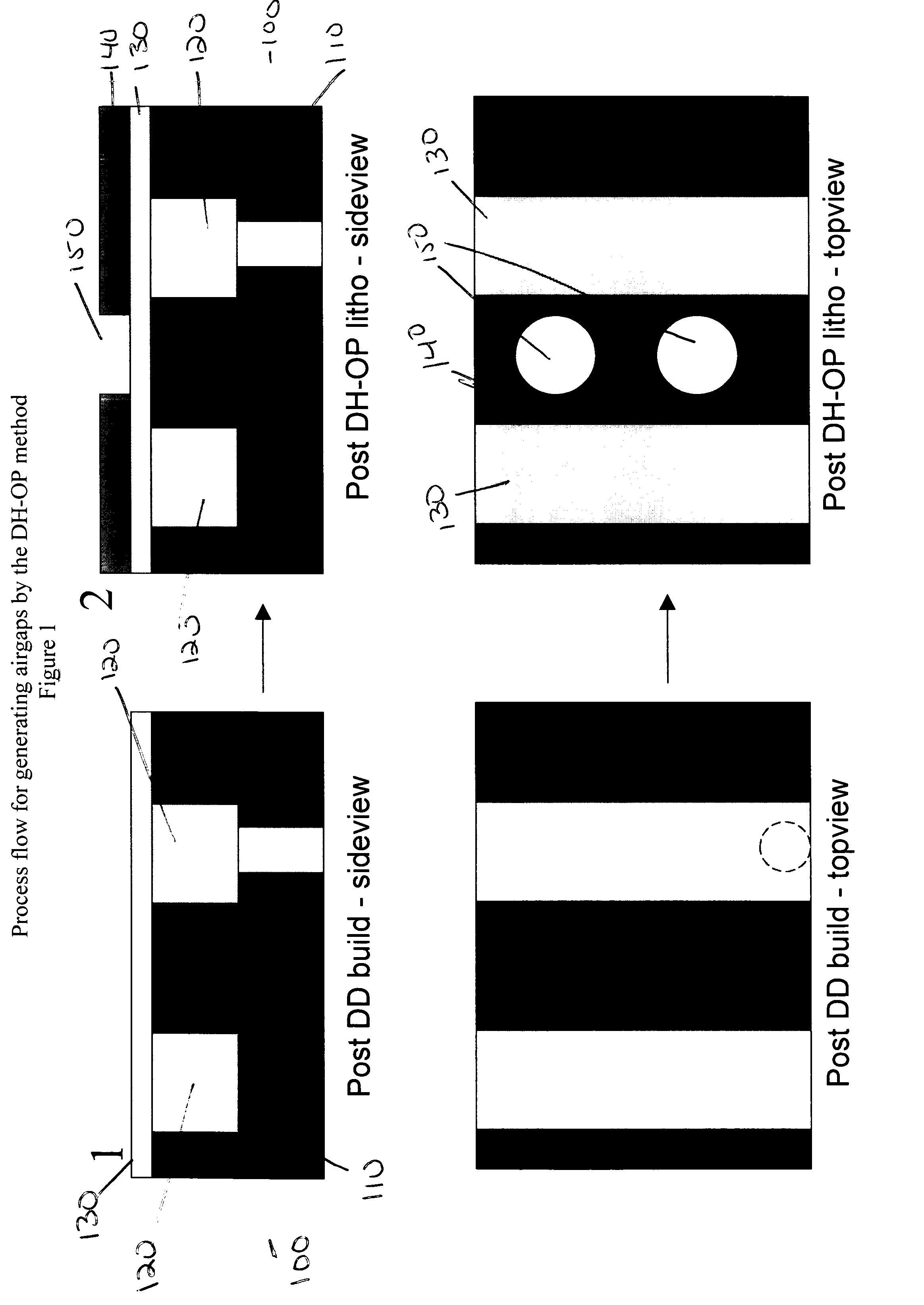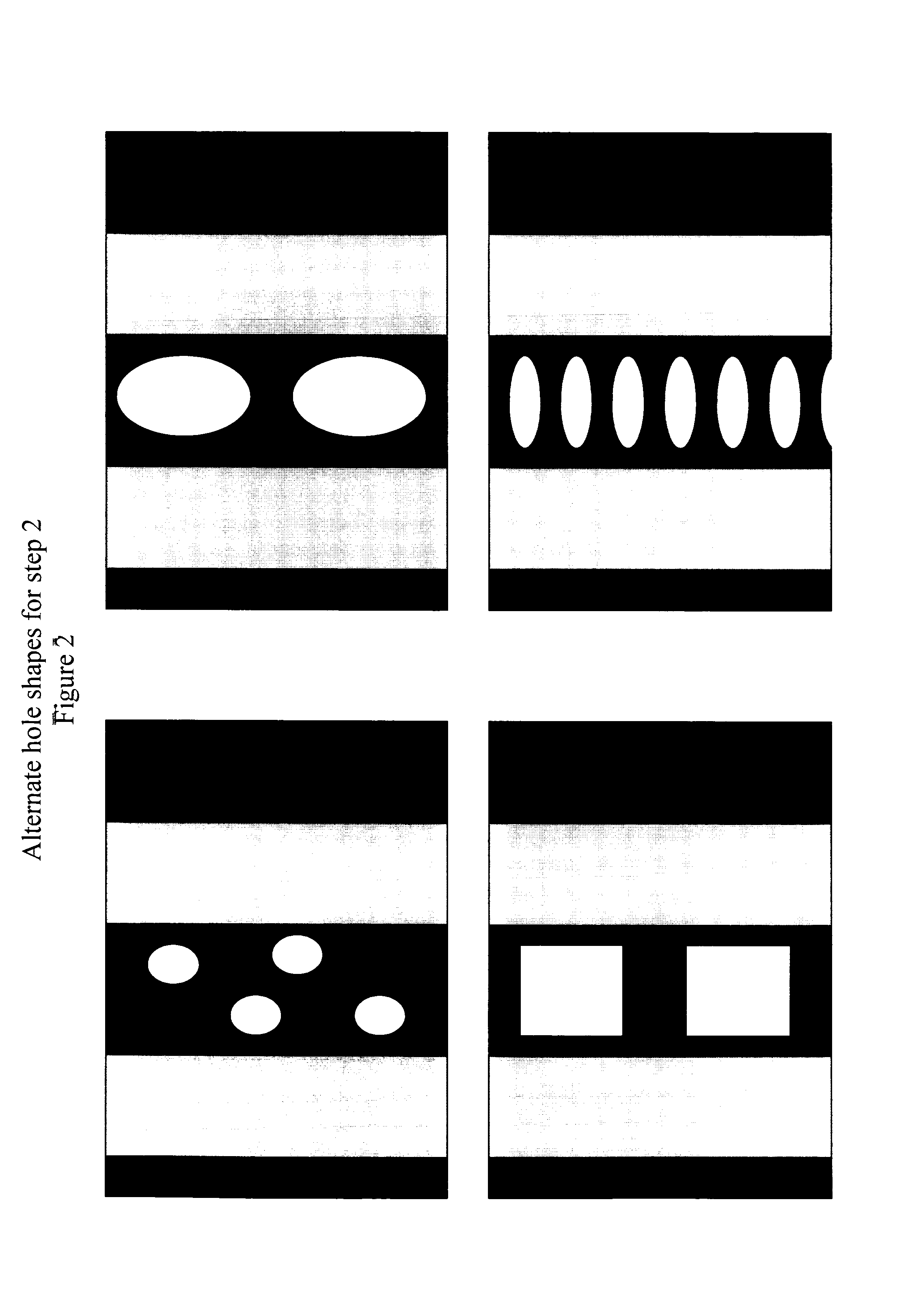Method to generate airgaps with a template first scheme and a self aligned blockout mask
a template first scheme and mask technology, applied in the field of methods, can solve the problems of poor mechanical strength, inability to achieve larger-scale copper wiring levels, and reliability issues in the final devi
- Summary
- Abstract
- Description
- Claims
- Application Information
AI Technical Summary
Benefits of technology
Problems solved by technology
Method used
Image
Examples
example 1
[0038]The desired interlevel dielectric on a semiconductor substrate was processed through a standard dual damascene scheme all the way to the deposition of the post-chemically-mechanically polished cap or thin hardmask. Following this, an antireflective coating and a standard 193 or 248 nm resist layer was coated on to the cap layer. A blockout mask, with perforations at least 50 nm or larger, was employed to print openings into the resist layer. Subsequently, the openings were transferred into the cap layer only. DHF was used as an etchant to etch out and remove the dielectric underneath the cap and leave behind a complete gap beneath a perforated cap. Finally, the openings in the cap were pinched-off during the deposition of the next level dielectric with very short pinch-off heights that are on the order of the perforation sizes and little or no topography at the top of the dielectric.
example 2
[0039]The desired interlevel dielectric on a semiconductor substrate was processed through a standard dual damascene scheme all the way to the deposition of the post-chemically-mechanically polished cap or thin hardmask. An antireflective coating and a standard 193 or 248 nm resist layer is coated on to the cap layer. A blockout mask with perforations that are at least 50 nm or larger is employed to print openings into the resist layer. The openings are transferred into and through the cap layer and into the underlying dielectric such that the openings are at least as deep as, or, preferably at least 25% deeper than the height of the interconnect wire. An oxidizing ash step is employed to remove the resist and further demethylate the remaining dielectric pillars if necessary. DHF is used as an etchant to remove the dielectric pillars underneath the cap and leave behind a complete gap beneath a perforated cap. Finally, the openings in the cap are pinched-off during the deposition of ...
example 3
[0040]The desired interlevel dielectric on a semiconductor substrate was processed through a standard dual damascene scheme all the way to the deposition of the post-chemically-mechanically polished cap or thin hardmask. An antireflective coating and a standard 193 or 248 nm resist layer is coated on to the cap layer. A blockout mask with perforations that are at least 50 nm or larger is employed to print openings into the resist layer. A conformal, thin, low temperature oxide layer is deposited such that the perforation openings are reduced by the thickness of the oxide layer. The oxide layer can be about 5 nm to 25 nm thick such that if the initial perforations are 75 nm in diameter, the diameter is reduced to about 65 to 25 nm respectively thus ensuring that the perforation sizes are sub-lithographic.
[0041]The openings are transferred into and through the cap layer and into the underlying dielectric such that the openings are at least as deep as, or, preferably at least 25% deepe...
PUM
 Login to View More
Login to View More Abstract
Description
Claims
Application Information
 Login to View More
Login to View More - R&D
- Intellectual Property
- Life Sciences
- Materials
- Tech Scout
- Unparalleled Data Quality
- Higher Quality Content
- 60% Fewer Hallucinations
Browse by: Latest US Patents, China's latest patents, Technical Efficacy Thesaurus, Application Domain, Technology Topic, Popular Technical Reports.
© 2025 PatSnap. All rights reserved.Legal|Privacy policy|Modern Slavery Act Transparency Statement|Sitemap|About US| Contact US: help@patsnap.com



